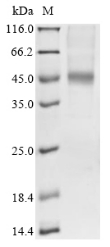Recombinant Human Fibroblast Growth Factor Receptor 1 (FGFR1) is expressed in yeast and contains amino acids 22 to 376 of the human protein. This partial protein carries an N-terminal 6xHis-tag, which makes purification and detection more straightforward. The product shows purity greater than 85% as verified by SDS-PAGE, which should provide reliable results for research applications. It's designed strictly for research use, with no biological functions or disease relevance stated.
FGFR1 belongs to the fibroblast growth factor receptor family and plays what appears to be a critical role in cell growth, differentiation, and angiogenesis. The receptor participates in several signaling pathways, including the MAPK and PI3K/AKT pathways—both seem pivotal for cellular communication and regulation. FGFR1 has become a key area of research interest, largely due to its likely involvement in developmental processes and various cellular functions.
Potential Applications
Note: The applications listed below are based on what we know about this protein's biological functions, published research, and experience from experts in the field. However, we haven't fully tested all of these applications ourselves yet. We'd recommend running some preliminary tests first to make sure they work for your specific research goals.
Human FGFR1 is a complex type I transmembrane receptor tyrosine kinase whose extracellular domain functionality depends on proper glycosylation, disulfide bond formation, and correct tertiary structure for ligand binding. While the yeast expression system provides an eukaryotic folding environment and can perform glycosylation, it produces high-mannose type glycans that differ significantly from the complex glycosylation patterns in mammalian cells. This glycosylation difference may affect the protein's ligand-binding affinity, specificity, and dimerization capability. The N-terminal 6xHis tag may potentially interfere with the protein's structural organization. Experimental validation is essential to confirm both structural integrity and functional ligand-binding activity.
1. Antibody Development and Validation Studies
Antibody development relies primarily on antigenic sequence recognition rather than specific glycosylation patterns. If correctly folded (verified), the protein is suitable for generating antibodies, though glycosylation differences may affect some conformational epitopes. If misfolded/unverified, it remains suitable for linear epitope antibody production.
2. Protein-Protein Interaction Studies
This application requires rigorous functional validation. FGFR1 interactions with FGF ligands require precise glycosylation and tertiary structure. If correctly folded and functionally validated with known ligands (verified), it can be used for qualitative interaction studies with appropriate controls acknowledging glycosylation differences (compared with the extracellular region of FGFR1 expressed in mammalian cells). If unverified or misfolded, it will yield misleading results and is not recommended.
3. Biochemical Characterization and Stability Studies
These studies are essential for determining folding status and basic biophysical properties. They can assess physical stability and general folding quality regardless of functional state, providing important quality control data.
Final Recommendation & Action Plan
The yeast-expressed FGFR1 extracellular domain is suitable for antibody development and biophysical characterization, but has significant limitations for functional interaction studies due to glycosylation differences. Begin with Application 3 (Biochemical Characterization) to assess basic folding quality. Application 1 (Antibody Development) can proceed immediately. For Application 2 (Interaction Studies), first validate ligand binding capability using surface plasmon resonance with known FGF ligands and compare binding kinetics with mammalian-expressed FGFR1 to assess glycosylation impact. Avoid ligand screening entirely for this preparation; use mammalian-expressed protein for any quantitative binding or inhibitor screening studies. Always acknowledge the glycosylation limitation when interpreting results from functional assays.






